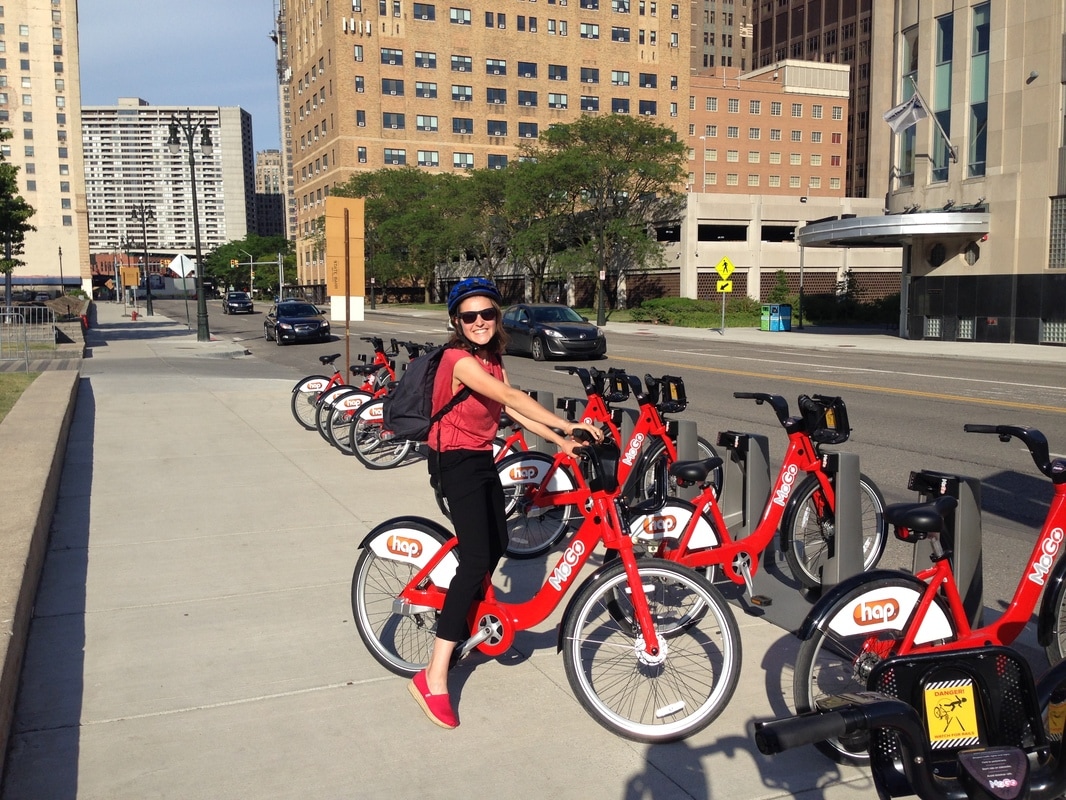These first few days of discovery in the Motor City have been filled with surprises and new experiences. Although I had grown accustomed to speaking with vivacity about the DIY-Detroiters and about changing the perception of a crime-ridden Detroit for my family and friends back home, I could not prepare myself for the bustling innovation and willpower emanating from the city. Every time someone asks me: how do you like Detroit so far? I have to tell them that it is the soul of the city that I connect with and feel, as I bike on the bustling roads, and play “I spy a community garden.” In many cities, you can spend weeks, visiting important landmarks and eating local foods, but without understanding what it means to be an urbanite living there. In Detroit, that is impossible. You straight away feel the way in which the city lives for its inhabitants: without Detroiters, there is no Detroit.
This feeling grew throughout Monday’s unique tour by the Detroit Experience Factory. Our discovery of the Heidelberg Project sparked my contemplative spirit and humility. I observed this art space and at first jumped to criticism: why not transform this into a community garden? How was this helping the community? These questions made me realize that I had to step back and acknowledge the fact that art could provide a unique opportunity to think about this challenged neighborhood. This space could be a way of bringing attention to the problems that these people face and a unique medium for them to express their struggle. It also made me cognizant of how people perceive urban farming and gardening in Detroit. Initially a community-prompted medium for the city’s revitalization, it now seems to be something that is “not enough” to bring back Detroit and that investing in embellishing the downtown area and bringing jobs to those in the forgotten neighborhoods is more important. As we were pursuing our bus tour towards the Heidelberg project, I spotted the Earth Works Farm I had read about in the book The Unsettlers. This mystical glimpse of the farm made me realize that I still had a lot to explore within the urban farming scene of Detroit.
Through my experience here, I hope to blend two worlds, that of a visionary Detroit of upcoming and forward-thinking mobility with MoGo and a booming urban farming scene. I hope that, whether I am biking from MoGo station to station, getting stopped by curious pedestrians who want to learn more about it and shouting MoGo with glee as a MoGo-er zips past, or getting my finger nails dirty at the Keep Growing Detroit Market Garden or Hubbard Farms Community Garden, I will be thinking about what a cohesively sustainable lifestyle can look like for a Detroiter and how rethinking the relationship between all of these new visions of the city can help it rise up even farther.
These first few days of discovery in the Motor City have been filled with surprises and new experiences. Although I had grown accustomed to speaking with vivacity about the DIY-Detroiters and about changing the perception of a crime-ridden Detroit for my family and friends back home, I could not prepare myself for the bustling innovation and willpower emanating from the city. Every time someone asks me: how do you like Detroit so far? I have to tell them that it is the soul of the city that I connect with and feel, as I bike on the bustling roads, and play “I spy a community garden.” In many cities, you can spend weeks, visiting important landmarks and eating local foods, but without understanding what it means to be an urbanite living there. In Detroit, that is impossible. You straight away feel the way in which the city lives for its inhabitants: without Detroiters, there is no Detroit.
This feeling grew throughout Monday’s unique tour by the Detroit Experience Factory. Our discovery of the Heidelberg Project sparked my contemplative spirit and humility. I observed this art space and at first jumped to criticism: why not transform this into a community garden? How was this helping the community? These questions made me realize that I had to step back and acknowledge the fact that art could provide a unique opportunity to think about this challenged neighborhood. This space could be a way of bringing attention to the problems that these people face and a unique medium for them to express their struggle. It also made me cognizant of how people perceive urban farming and gardening in Detroit. Initially a community-prompted medium for the city’s revitalization, it now seems to be something that is “not enough” to bring back Detroit and that investing in embellishing the downtown area and bringing jobs to those in the forgotten neighborhoods is more important. As we were pursuing our bus tour towards the Heidelberg project, I spotted the Earth Works Farm I had read about in the book The Unsettlers. This mystical glimpse of the farm made me realize that I still had a lot to explore within the urban farming scene of Detroit.
Through my experience here, I hope to blend two worlds, that of a visionary Detroit of upcoming and forward-thinking mobility with MoGo and a booming urban farming scene. I hope that, whether I am biking from MoGo station to station, getting stopped by curious pedestrians who want to learn more about it and shouting MoGo with glee as a MoGo-er zips past, or getting my finger nails dirty at the Keep Growing Detroit Market Garden or Hubbard Farms Community Garden, I will be thinking about what a cohesively sustainable lifestyle can look like for a Detroiter and how rethinking the relationship between all of these new visions of the city can help it rise up even farther.

 RSS Feed
RSS Feed
